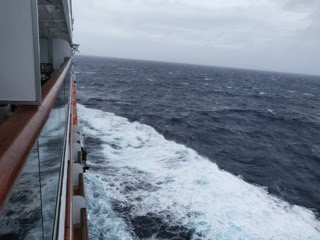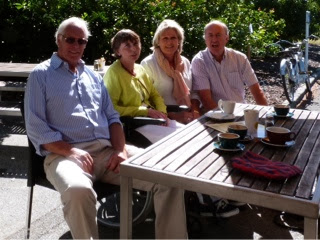The sun was shining and it was hot as we approached Honolulu, located on the island of Oahu. A beautiful day and Honolulu looked splendid as we drew alongside Pier 2.
Hilo, Hawai’i
The largest island in the Hawaiian group is called Hawai’i or Big Island and Hilo is the county capital. It is known as the gateway to the land of fire and brimstone and volcanos abound on the island.


 The two main volcanoes are Mauna Loa and the more active Kilauea. They are sited in the Hawaiian Volcanoes National Park. Kilauea has been erupting for the last 20 years.
The two main volcanoes are Mauna Loa and the more active Kilauea. They are sited in the Hawaiian Volcanoes National Park. Kilauea has been erupting for the last 20 years.Equator
We have just crossed the Equator again. But there is a big dilemma and dispute aboard QV. It is about water. Not the water in the ocean. That is now calm and the effects of another Cyclone (called Mike) have disappeared. As you will know the Pacific is the largest of the world’s oceans so there is no shortage of the stuff there.
There is the water made on the ship and then there is the water that goes down the plughole. And that’s where the problem lies.
Pago Pago, American Samoa
We did eventually get to the 18 March after crossing the IDL. And on that day we arrived in Pago Pago (pronounced Pango Pango). The Samoan group of islands are divided into Samoa (once Western Samoa) – an independant nation and American Samoa where we were. Tutuila is the largest island in the American Samoa group and Pago Pago is the capital.
The Kingdom of Tonga
En Route to Nuku’Alofa, Tonga
We survived Tropical Cyclone Lusi. The waves measured 7 metres and the wind reached Force 8 on the Beaufort scale. It was less severe than the storm in the Bay of Biscay and Atlantic that we experienced in the first week of this voyage.
Auckland
Auckland is known as “The City of Sails”. It was a wonderful sunny day when we arrived before 0700. The Cruise terminal is at the bottom of Queen Street which is the backbone of the City and it is easy to explore on foot.
Cyclone Lusi
Before I tell you about Auckland I need to organise my photos but for those of you following our progress by satellite I have to report a change of plan.
Napier
but because of its height and the difficulty of getting Jane into it, it was agreed that she would come in Bruce’s very respectable Subaru. Bruce bowled up in the new car when we stopped for coffee.
Wellington
We like Wellington. Strangely Captain James Cook did not appear to be excited about it. In 1773 he anchored about a mile outside the harbour and went no further.
Championship taking place with scores of teams involved. Our visit this year was on a Monday and the Waterfront was less frenetic, but it was a beautiful day and the locals and the tourists were out in force enjoying the autumn sun.






























































